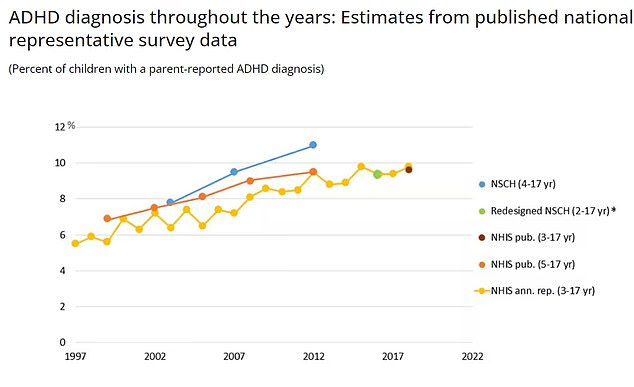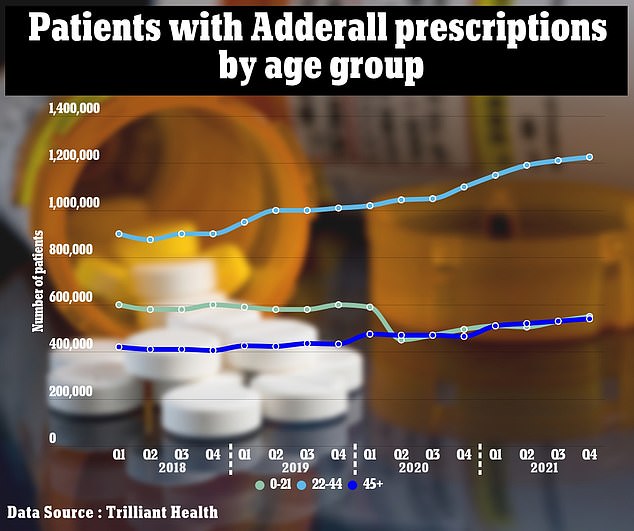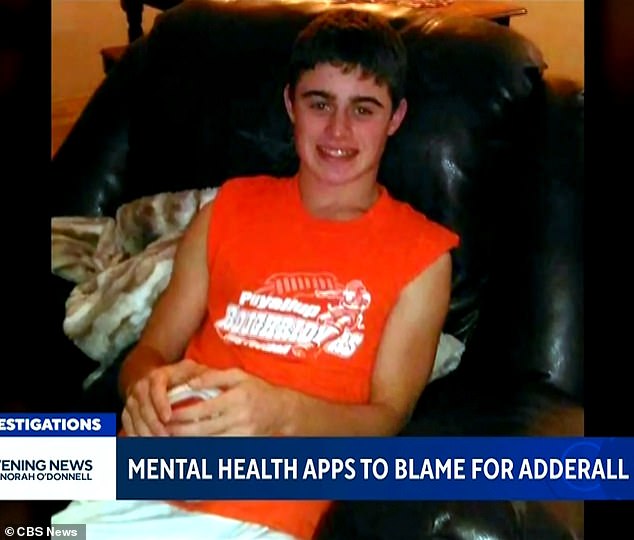Officials are sounding the alarm about Adderall’s sky-high prescription rates, warning that abuse of the drug could lead to the next opioid-like epidemic.
One DEA chief compared the influx of new prescriptions and high risk of abuse to that of opioids in the early and mid-2000s.
The medications have been linked to insomnia, anxiety, seizures, hallucinations and psychosis, and there is some evidence that they may increase the risk of heart disease.
Matthew Strait, deputy assistant administrator of the DEA’s diversion control division, said: ‘I’m not trying to be a doomsayer here… It makes me feel like we’re on the brink of our next drug crisis in the United States.’
Prescriptions skyrocketed during the pandemic with the rise of telehealth companies: prescriptions went from 35.5 million in 2019 to 45 million last year.
Elijah Hanson (pictured), 21, committed suicide in June. He had suffered from mental health problems for years. His family said a recent Adderall prescription he obtained through Cerebral played a role in his death.

The CDC chart shows the percentage of children with a parent-reported diagnosis of ADHD. One in seven children currently suffers from attention deficit hyperactivity disorder in the United States. For boys and girls ages five to 17 combined, the prevalence was 11.3 percent, or about one in 10.
The DEA is working on new safeguards for overprescribing the controlled substance, which will affect how much of the drug is manufactured and how many people can access it.
The opioid epidemic in the United States has killed about 600,000 people and its effects are still being felt today despite increasingly strict prescriptions. Many experts believe the fentanyl crisis was fueled by opioid-addicted patients whose supply of prescription drugs was reduced.
Deaths due to Adderall use alone are rare and are usually linked to other fatal substances such as heroin, which can lead to overdose.
But the drug, which is a stimulant similar to methamphetamine and cocaine, is highly addictive and people sometimes turn to street versions, which can contain even more harmful substances.

The above shows the number of Adderall prescriptions given to age groups per year. Shows under 21 (light green), 22 to 44 years (light blue) and over 45 (dark blue)
During the pandemic, when millions of Americans were stuck in isolation in an effort to avoid infection, telehealth companies like Cerebral flourished, offering people a lifeline when they otherwise couldn’t see their regular doctors.
But Cerebral, which requires users to be 18, and others have come under intense scrutiny for what researchers have considered overly liberal diagnoses of ADHD.
Overdiagnosis is a problem because it leads to overtreatment.
Arrive Health, a health technology company based in Denver, Colorado, estimates that ADHD medications now account for 2.3 percent of all prescriptions written in the United States.
This is more than double the figure from January 2020, just before the pandemic began, when the drug accounted for just one percent of prescriptions.
David Goodman, a psychiatrist and assistant professor at Johns Hopkins University School of Medicine, told Bloomberg: ‘The crisis, so to speak, is not in the prescription of the drug.
“The crisis is in the precision of the diagnosis.”
An estimated 6.1 million children and adolescents have been diagnosed with ADHD in the United States, compared to around 3.3 million in the EU.
Overprescribing has had disastrous consequences. For example, Elijah Hanson, 21, was found dead by his family on the kitchen floor in Tacoma, Washington, on June 25 after filming himself playing Russian roulette with a loaded gun.
He had been abusing Adderall in the months before his death, having been able to obtain a prescription online by lying to telehealth providers, even though he had previously suffered other mental health problems.
There are currently no standards for diagnosing adults with ADHD, although specialists have been working for about two years to establish them, according to the Wall Street Journal.
ADHD affects adults, although it is often diagnosed in children, who are also prone to over-prescription and over-diagnosis.
An estimated one in four American teenagers in some schools abuses prescription stimulants like Adderall, according to NIH research.
Meanwhile, the CDC reported that the percentage of children with a parent-reported ADHD diagnosis has steadily increased over time.
The agency found that 14.5 percent of American children have developmental problems related to poor concentration, up from just under ten percent in 2000.
One in seven children currently suffers from attention deficit hyperactivity disorder in the United States. For boys and girls ages five to 17 combined, the prevalence was 11.3 percent, or about one in 10.
The biggest report in 2021 They found that the diagnosis of ADHD has increased worldwide since the 1980s, but there was no corresponding increase in ADHD symptoms during that time.
Dr Luise Kazda, a researcher at the University of Sydney who was involved in the study, said: “Children today, on average across the population, are as symptomatic as they were 20 or 30 years ago,” she said.
‘So there hasn’t been this huge increase in the number of hyperactive or distracted children; that really remained very stable.”
The article concluded that there was “compelling evidence” of overdiagnosis and overtreatment of ADHD in children and adolescents.
Overprescribing is what fueled the opioid epidemic. It arose from the message spread by pharmaceutical companies that pain is another vital sign that doctors must address and should always be treated to the best of their ability. That included prescribing painkillers.
In the mid-2000s, opioids flooded cities large and small. In Cabell County, West Virginia, which was once called the “epicenter” of the epidemic. Drug wholesalers AmerisourceBergen, Cardinal Health and McKesson shipped approximately 81 million highly addictive opioid pills to pharmacies in Huntington, located in the county.
Overprescribing gave way to an explosion in heroin use on the streets, followed by fentanyl, a much cheaper synthetic opioid that has permeated the drug supply and infiltrated other drugs such as heroin and Xanax, increasing dramatically increases the chance that a person will overdose and die.
The amount of potentially fatal fentanyl could fit on the tip of a pencil and is approximately 100 times more potent than morphine.

